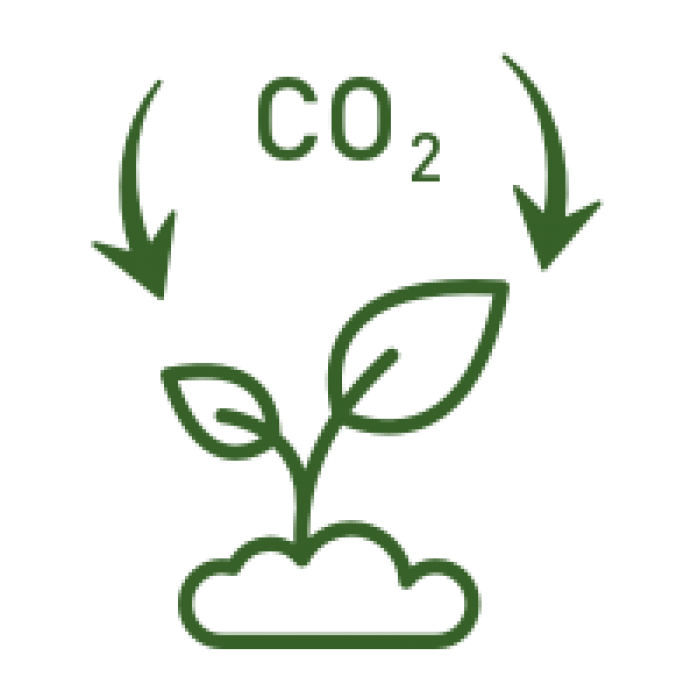
What we do
It is simple, NuaTree work with a range of partners in order to reforest Ireland with predominantly native woodland and, in so doing, create a more sustainable future for people and wildlife.
Why do we reforest?
In the Ireland of the imagination we often conjure up dramatic, windswept landscapes dotted with stone cottages. This beautiful barren scene still covers much of Ireland’s upland regions, and while it may appear visually dramatic, it doesn’t actually reflect the Ireland that nature intended.
The truth is that almost all of this island was once clothed with trees, huge tracts of forest dominated by Oak and Elm covered over 95% of the country. Like most of Europe, many of Ireland’s woodlands were cleared to make way for agriculture, but Ireland also suffered from extensive clearance of its forests by profiteers who had little regard for the devastation it would leave. Today, while the average tree cover for much of mainland Europe is approximately 40%, Ireland’s native tree cover languishes at only 1%. Another 9% made up of new non-native conifer stands, often planted on blanket bogs, an endangered habitat in its own right (which are often severely damaged in this process). This new forestry is dominated by large monocultures which further limits biodiversity and leaves much of the Irish timber industry vulnerable to disease.
NuaTree believe that new woodlands comprising mainly native trees offers a better long term solution for:

Carbon Storage
Trees have a major impact on climate. The carbon content of trees is, on average, between 48% and 50%. This makes trees one of the planets greatest carbon stores. However, the temperate rainforest of Ireland can store many times more carbon in the deep brown soils under canopy than in the trees themselves. This makes Ireland’s woodlands especially important as a carbon sink. By replanting Ireland’s temperate rainforest, they will continue to store carbon for centuries to come and help Ireland play its role in mitigating climate change.
‘Trees are one of the planets great carbon stores – Ireland’s temperate rainforests store many more times the amount of carbon in their soils than in trees alone’

Native woodlands as a sustainable resource for rural communities
Woodland provides many other local benefits. Future provision of sustainable fuel-wood promises to contribute to reducing carbon emissions by reducing Ireland’s high dependency on fossil fuels. As a clean, renewable and local heating fuel, availability of wood will help combat fuel poverty which is the blight of many rural communities. Native timber, from sustainable woodlands, will also provide a renewable natural resource for many industries, including construction and furniture making. Woodlands with pathways through them, open up heretofore non-accessible countryside for walkers and hikers, this in turn increases sustainable tourism which helps to further support rural communities.
Agriculture is still rural Ireland’s largest industry, the mainstay of the rural economy. The farming landscape in Europe typically contains between 25% and 45% native woodland. Irish farmland contains less than 1% native woodland. By strategically planting belts of trees, hedges and larger areas of woodland, farm productivity can be increased. This happens because trees provide shelter from the wind (Ireland is one of the windiest places in Europe!), which increases crop growth and protects livestock. Remarkably trees also reduce surface water on farmland, by channelling the water away from the surface into the deep soil. In Ireland, drier, sheltered land is better for crops and animals, reducing disease and in some cases the reliance on expensive winter housing for livestock.
‘Woodland shelters against wind thus protecting farmland, crops, homes and communities.’

Woodlands for Wildlife and biodiversity
Woodland is Ireland’s natural climax vegetation. Woodland dominated by native trees supports a high diversity of flora and fauna. The return of woodlands dominated by native trees will see a huge increase in native plants and animals. Woodlands have an impact far beyond their canopy, the shelter they provide will also support many populations of plants and animals in adjacent habitats.
‘Woodland is Ireland’s natural climax vegetation, woodland dominated by native trees supports a high diversity of flora and fauna'

Protection against flooding and drought
Extreme weather events, including floods and drought are becoming an increasingly frequent occurrence in Ireland. High rainfall events are often too great for conventional engineering solutions. However, green solutions are all around us. Woodland soils have huge water storage capacity. Woodlands have over 60 times or 6000% better ability to absorb water than pasture land. By planting woodlands in strategic places within river catchments, we can significantly reduce the impact on communities. The water that is channelled into the deep soil under trees, is then released more slowly into the rivers over weeks and months. The impact of trees normalises flow so that rivers are less likely to flood yet also more likely to retain even flows during periods of dry weather. This has positive impacts in reducing flooding, improving drinking water supplies and supporting agriculture, fisheries and wildlife.
“Woodland reduces the impact of extreme weather. Soils under temperate woodland are over 60 times more permeability than soils under pasture, this allows soils to act as a water store, reducing both the impacts of floods and drought"

Protecting vulnerable species
Many of Ireland’s most vulnerable species rely on native woodland. Creatures like the Golden Eagle and Red Squirrel are ‘flag ship species’ with their presence indicating a healthy ecosystem. When Ireland lost her woodlands many native species became extinct on the island. Over a century ago, that last remaining Golden Eagles disappeared, due by habitat loss and persecution. A project to reintroduce the Golden Eagle in the north west of Ireland is being hampered by poor breeding success due to an impoverished ecosystem with few prey animals for the eagles to hunt. In increase in diverse native woodland will create new habitats and increase biodiversity, in turn increasing the number of prey species that Eagles hunt.
Irish Red Squirrels are still vulnerable. Red squirrels thrive in native woodlands especially if they include include Scots Pine and Hazel. By increasing the amount of native woodland we can help to assure the squirrels future.
There are a myriad of plant, fungi and animal species that rely on native woodland to provide them a home. As the number of native woodlands increase these important new habitats will allow a wide range species to regain a foothold and move across that landscape. For example, most species of native bees within Ireland are in decline because wild pollinators are totally reliant on resources available in and increasingly impoverished landscape. It has been shown that natural habitats, such as woodland are essential in providing refuge areas for these insects. Creating woodland refuges allows bees and other pollinator populations to consolidate and grow again. Healthy populations of these insects will be more able to carry out essential ecosystem services, like pollinating agricultural crops which contribute to the rural economy.
